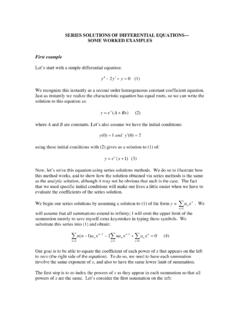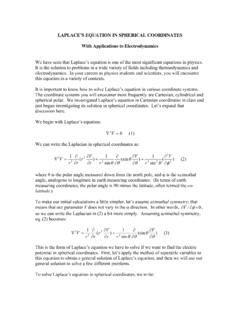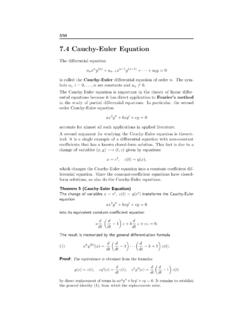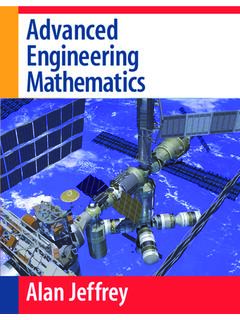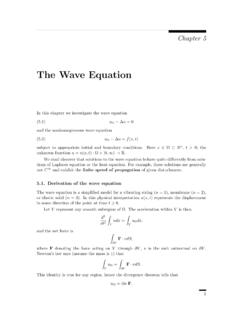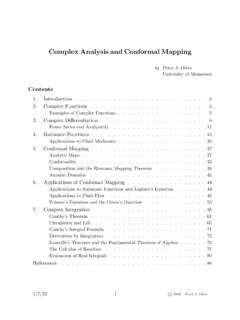Transcription of LAPLACE’S EQUATION IN SPHERICAL COORDINATES
1 LAPLACE S EQUATION IN SPHERICAL COORDINATES With Applications to Electrodynamics We have seen that Laplace s EQUATION is one of the most significant equations in physics. It is the solution to problems in a wide variety of fields including thermodynamics and electrodynamics. In your careers as physics students and scientists, you will encounter this EQUATION in a variety of contexts. It is important to know how to solve Laplace s EQUATION in various coordinate systems. The coordinate systems you will encounter most frequently are Cartesian, cylindrical and SPHERICAL polar. We investigated Laplace s EQUATION in Cartesian COORDINATES in class and just began investigating its solution in SPHERICAL COORDINATES . Let s expand that discussion here.
2 We begin with Laplace s EQUATION : 02= V (1) We can write the Laplacian in SPHERICAL COORDINATES as: )(sin1)(sinsin1)(122222222 + + = VrVrrVrrrV (2) where is the polar angle measured down from the north pole, and is the azimuthal angle, analogous to longitude in earth measuring COORDINATES . (In terms of earth measuring COORDINATES , the polar angle is 90 minus the latitude, often termed the co-latitude.) To make our initial calculations a little simpler, let s assume azimuthal symmetry; that means that our parameter V does not vary in the direction. In other words, 0/= V, so we can write the Laplacian in (2) a bit more simply. Assuming azimuthal symmetry, eq. (2) becomes: )(sinsin1)(12222 + = VrrVrrrV (3) This is the form of Laplace s EQUATION we have to solve if we want to find the electric potential in SPHERICAL COORDINATES .
3 First, let s apply the method of separable variables to this EQUATION to obtain a general solution of Laplace s EQUATION , and then we will use our general solution to solve a few different problems. To solve Laplace s EQUATION in SPHERICAL COORDINATES , we write: 0)(sinsin1)(12222= + = VrrVrrrV (4) First Step: The Trial Solution The first step in solving partial differential equations using separable variables is to assume a solution of the form: )()( =rRV (5) where R(r) is a function only of r, and ( ) is a function only of . This means that we can set: )()();()( = = rRVrRrV (6) Substituting the relationships in (6) into (4) produces: 0))((sinsin)())(()(2222= + = rrRrRrrrV (7) If we multiply each term in (7) by r2 and then divide each term by V = R(r) ( ), we obtain: 0))((sinsin)(1))(()(122= + = ddrRrdrdrRV (8) Notice that the derivates in (8) are no longer partial derivatives.
4 This is because the method of separable variables has produced two terms; one is solely a function of r and the other is solely a function of . Second Step: Separating Variables EQUATION (8) allows us to separate Laplace s EQUATION into two separate ordinary differential equations ; one being a function of r and the other a function of . As we have discussed in class, we realize that each term on the right hand side of (8) is equal to a constant. This means we can separate (8) into: )1())((sinsin)(1)1())(()(12+ = += llddandllrRrdrdrR (9) We now have two different ordinary differential equations which we will solve. We realize that the product of solutions will allow us to use eq. (5) (along with appropriate boundary conditions) to determine the solution to Laplace s EQUATION .
5 You may wonder we we choose to write the separation constant as something as non-obvious as l(l+1). The reason is that we have read ahead in the script, and know that by writing the separation constant in this way we will produce a well known differential EQUATION whose solution we already know. Notice that separation constant is positive in one EQUATION (the radial part) and negative in the other (the angular part); this is necessary so that the sum of equations is zero as required by Laplace s EQUATION . The radial EQUATION Let s start by solving the radial EQUATION of eq. (9). We multiply through by R(r) and expand the derivate to find: 0)1(2222=+ +RlldrdRrdrRdr (10) This is a fairly simple example of a Frobenius (see )differential EQUATION .
6 This is also an example of an Euler (or Cauchy) differential EQUATION . See for more details about solving Euler s EQUATION . Using either the method of Frobenius or methods of Euler s equations , we can find the solution to EQUATION (10): )1()(+ +=llBrArrR (11) where A and B are constants which will be determined once we apply specific boundary equations . The angular EQUATION We solve the angular portion of EQUATION (9) by multiplying through by ( ) and expanding the derivative to obtain: 0)1(sincos22= ++ + lldddd (12) This is actually a differential EQUATION you are very familiar with, although perhaps not in this exact form. Refer back to the solutions for the very first homework set of the semester, and review again the solutions to problems 4 and 5.
7 You will see that the EQUATION you have derived in (12) is just the well known Legendre EQUATION . We know that the solutions to the Legendre EQUATION are the Legendre polynomials, Pl (cos ). Third Step: Constructing the complete solution Having separated Laplace s EQUATION into two ordinary differential equations , we can use the results above to substitute into eq. (5) to realize that the general solution to Laplace s EQUATION in SPHERICAL COORDINATES will be constructed of a sum of solutions of the form: )(cos)(),()1( lllPBrArrV+ += (13) From our experience with Laplace s EQUATION in Cartesian COORDINATES , we know that the full solution will be constructed by taking a sum of solutions of the form of (13); in other words, our general solution to Laplace s EQUATION in SPHERICAL COORDINATES is: )(cos)(),()1(0 llllllPrBrArV+ =+= (14) Now, all we need are boundary conditions to determine the values of the coefficients Al and BBl.
8 Applying Boundary Conditions First Example (Boas pp. 647-649) Let s see how we can use (14) as the starting point to determine a solution to Laplace s EQUATION with specific boundary conditions. For this purpose, let s use the example in Boas pp. 647-649. Without any loss of meaning, we can use talk about finding the potential inside a sphere rather than the temperature inside a sphere. So, let s assume there is a sphere of radius a, and the potential of the upper half of the sphere is kept at a constant +100, and the potential of the lower half of the sphere is held at 0. How can we determine the potential at any point inside the sphere? First, let s write the boundary conditions as: << <<<<<<=0cos12/,01cos02/0,100 ororVRemember that the north pole of the sphere corresponds to =0, and = /2 in the equatorial plane.
9 Now, let s look a bit more closely at (14). We are asked to find the potential at any point inside the sphere. This regime includes, of course, the point r=0, and we can look at (14) and realize that the solution diverges at r=0 unless BBl =0. Applying the necessity for a meaningful physical solution to this problem allows us to set all coefficients Bl Bto zero, so that (14) simplifies to: )(cos),(0 llllPrArV == (15) Now, we use the boundary condition for the surface of the sphere. When r = a, we know that V = 100 in the upper half sphere and V = 0 in the lower half sphere. This means we can write (15) as: 1cos0100)(cos),(0<<== = forPaArVllll (16) The expression in (16) should look familiar to us: we are seeking to write a function (in this case the function equals the constant 100) in terms of an infinite series.
10 We have seen how to do this using both Fourier series and Legendre Polynomials. We know that our function can be expanded in a series if and only if we can expand that function in terms of a complete set of orthogonal functions. Fourier series are possible because sin and cos represent a complete set of orthogonal functions on (- , ); expansion in terms of Legendre polynomials is possible since we have learned that Legendre polynomials are a complete set of orthogonal functions on (-1, 1). Thus, we can expand any function f(x) on (-1, 1) as: ==0)()(lllxPcxf (17) where the coefficients, cl are determined by: +=11)()(212dxxPxflcll (18) We can see that EQUATION (17) applies to eq. (16) with f(x) = 100, and cl = Al al, or lllacA= (19) All we have to do now is determine the values of the coefficients cl from (18), substitute these values into (19) and then use those values of Al in (15) to determine the complete solution to the potential inside the sphere.
